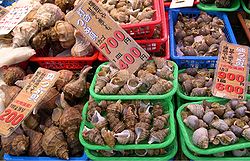This article needs additional citations for verification .(May 2018) |


Whelks are any of several carnivorous sea snail species [1] with a swirling, tapered shell. Many are eaten by humans, such as the common whelk of the North Atlantic. Most whelks belong to the family Buccinidae and are known as "true whelks." Others, such as the dog whelk, belong to several sea snail families that are not closely related.
Contents
- Usage
- Asia
- Australia, New Zealand
- Brazil
- United Kingdom and Ireland, Belgium, Netherlands
- United States
- West Indies
- Some common examples
- See also
- References
- External links
True whelks (family Buccinidae) are carnivorous, and feed on annelids, crustaceans, mussels and other molluscs, drilling holes through shells to gain access to the soft tissues. Whelks use chemoreceptors to locate their prey. [2]
Many have historically been used, or are still used, by humans and other animals as food. In a 100-gram (3+1⁄2-ounce) reference serving of whelk, there are 570 kilojoules (137 kilocalories) of food energy, 24 g of protein, 0.34 g of fat, and 8 g of carbohydrates. [3]
Dog whelk, a predatory species, was used in antiquity to make a rich red dye that improves in color as it ages. [4]

